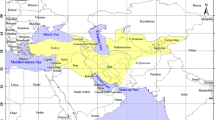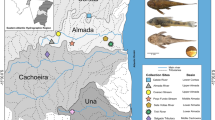Abstract
The phylogenetic relationships of two cavefish, Phreatichthys andruzzii and Garra barreimiae, belonging to the family Cyprinidae, were investigated by sequencing the mitochondrial cytochrome b gene. These cavefish species are native to Somalia (eastern Africa) and Oman (southeastern Arabian peninsula), respectively, and so far no molecular support to their taxonomy and phylogenetic position was ever provided. The analysis of cytochrome b sequences showed that the species are monophyletic taxa, closely related to each other and to other species of the genus Garra. Molecular clock calculations allowed to date the origin of these hypogaean species back to the Plio-Pleistocene and support the hypothesis that African cyprinids originated from Miocenic immigrations of Asian ancestors.


Similar content being viewed by others
References
Banister KE (1984) A subterranean population of Garra barreimiae (Teleostei: Cyprinidae) from Oman, with comments on the concept of regressive evolution. J Nat Hist 18:927–938 doi:10.1080/00222938400770811
Banister KE, Bunni MK (1980) A new blind cyprinid fish from Iraq. Bull Br Mus Nat Hist Zool 38(3):151–158
Briggs JC (1979) Ostariophysan zoogeography: an alternative hypothesis. Copeia 1:111–118 doi:10.2307/1443735
Cane MA, Molnar P (2001) Closing of the Indonesian seaway as a precursor to east African aridification around 3–4 million years ago. Nature 411:157–162 doi:10.1038/35075500
Cavender GJ (1991) The fossil record of the cyprinidae. In: Winfield IJ, Nelson JS (eds) Cyprinid fishes – systematics, biology and exploitation. Chapman & Hall, London, pp 34–54
Christman MC, Culver DC (2001) The relationship between cave biodiversity and available habitat. J Biogeogr 28:367–380 doi:10.1046/j.1365-2699.2001.00549.x
Cobolli-Sbordoni M, De Matthaeis E, Mattoccia M et al (1996) Genetic variability and differentiation of hypogean Cyprinid fishes from Somalia. J Zoolog Syst Evol Res 34:75–84
Culver DC, Kane TC, Fong R et al (1990) Morphology of cave organisms – it is adaptive. Mem Biospeol 17:13–26
deMenocal PB (1995) Plio-Pleistocene African climate. Science 270(5233):53–59
deMenocal PB (2004) African climate change and faunal evolution during the Pliocene–Pleistocene. Earth Planet Sci Lett 220:3–24
Drummond AJ, Rambaut A (2007) BEAST: Bayesian Evolutionary Analysis Sampling Trees. Version 1.4.1. http://evolve.zoo.ox.ac.uk/beast/
Durand JD, Tsigenopoulos CS, Ünlü E et al (2002) Phylogeny and biogeography of the family cyprinidae in the Middle-East inferred from cytochrome b DNA – evolutionary significance of this region. Mol Phylogenet Evol 22(1):91–100
Ercolini A, Berti R (1975) Light sensitivity experiments and morphology studies of the blind phreatic fish Phreatichthys andruzzii Vinciguerra from Somalia. Monit Zool Ital 6(Suppl):29–43
Ercolini A, Berti R, Chelazzi L et al (1982) Researches on the phreatobic fishes of Somalia: achievements and prospects. Monit Zool Ital (N.S.) 17(Suppl):219–241
Ercolini A, Berti R, Chelazzi L et al (1987) Oxygen consumption in hypogean and epigean cyprinids (Pisces). Monit Zool Ital (N.S.) 22(Suppl):23–30
Felsenstein J (2002) PHYLIP 3.6 (Phylogeny Inference Package) version 3.6a3. Dept. of Genome Science, Univ. of Washington, Seattle, WA. http://evolution.gs.washington.edu/phylip.html
Feulner GR (1998) Wadi fish of the UAE. Tribulus 8(2):16–22
FishBase (2006) World Wide Web electronic publication. Froese R, Pauly D (eds) http://www.fishbase.org. Cited 22 Feb 2007
Fowler HW, Steinitz H (1956) Fishes from Cyprus, Iran, Iraq, Israel and Oman. Bull Res Counc Isr 5B:260–292
Greenwood PH (1973) Fish fossils of the late Miocene of Tunisia. Notes Serv Géol Tunisie 37:41–72
Guindon S, Gascuel O (2003) A simple, fast, and accurate algorithm to estimate large phylogenies by maximum likelihood. Syst Biol 52(5):696–704
Hernández Fernández M, Vrba ES (2005) Plio-Pleistocene climatic change in the Turkana Basin (East Africa): evidence from large mammal faunas. J Hum Evol 50:595–626
Huelsenbeck JP, Ronquist FR (2001) MRBAYES: Bayesian inference of phylogeny. Bioinformatics 17:754–755
Jeffery WR (2001) Cavefish as a model system in evolutionary developmental biology. Dev Biol 231:1–12
Kimura M (1980) A simple method foe estimating evolutionary rates of base substitutions through comparative studies of nucleotide sequences. J Mol Evol 16:111–120
Kocher TD, Thomas WK, Meyer A et al (1989) Dynamics of mitochondrial DNA evolution in animals: amplification and sequencing with conserved primers. Proc Natl Acad Sci USA 86:6196–6200
Kotlík P, Berrebi P (2001) Phylogeography of the barbel (Barbus barbus) assessed by mitochondrial DNA variation. Mol Ecol 10:2177–2185
Kruskal JB (1964) Multidimensional scaling by optimizing goodness of fit to a nonmetric hypothesys. Psychometrika 29:1–27
Kumar S, Tamura K, Nei M (2004) MEGA3: integrated software for molecular evolutionary genetics analysis and sequence alignment. Brief Bioinf 5:150–163
Levin NE, Quade J, Simpson SW et al (2004) Isotopic evidence for Plio-Pleistocene environmental change at Gona, Ethiopia. Earth Planet Sci Lett 219:93–110
Mayr E (1969) Principles of systematic zoology. McGraw-Hill, New York
Otero O (2001) The oldest-known cyprinid fish of the Afro-Arabic plate, and its paleobiogeographical implications. J Vertebr Paleontol 21(2):386–388
Otero O, Gayet M (2001) Palaeoichthyofaunas from the Lower Oligocene and Miocene of the Arabian Plate: palaeoecological and palaeobiogeografical implications. Palaeogeogr Palaeoclimatol Palaeoecol 165:141–169
Pääbo S, Thomas WK, Whitfield KM et al (1991) Rearrangements of mitochondrial transfer RNA genes in marsupials. J Mol Evol 33:426–430
Pellegrin J (1932) Les Cyprinidés cavernicole d’Afrique. Archo Zool Ital 16:622–629
Posada D, Crandall KA (1998) Modeltest: testing the model of DNA substitution. Bioinformatics 14:817–818
Proudlove GS (2001) The conservation status of hypogean fishes. Environ Biol Fish 62:201–213
Rambaut A, Drummond AJ (2005) Tracer v 1.3. http://evolve.zoo.ox.ac.uk/software/tracer
Reynolds J, Weir BS, Cockerham CC (1983) Estimation for the coancestry coefficient: basis for a short-term genetic distance. Genetics 105:767–779
Romero A (2001) Scientists prefer them blind: the history of hypogean fishes research. Environ Biol Fish 62:43–71
Romero A, Paulson KM (2001) It’s a wonderful hypogean life: a guide to the troglomorphic fishes of the world. Environ Biol Fish 62:13–41
Sanjur OI, Carmona JA, Doadrio I (2003) Evolutionary and biogeographical patterns within Iberian populations of the genus Squalius inferred from molecular data. Mol Phylogenet Evol 29:20–30
Schneider S, Roessli D, Excoffier L (2000) Arlequin ver 2.000: A software for population genetics analysis. Dept. of Anthropology and Ecology, University of Geneva, Switzerland. http://lgb.unige.ch/arlequin/software
StatSoft Inc. (2004) Statistica (data analysis software system), Version 7. www.statsoft.com
Strecker U, Bernatchez L, Wilkens H (2003) Genetic divergence between cave and surface populations of Astyanax in Mexico (Characidae, Teleostei). Mol Ecol 12:699–710
Swofford DL (2003) PAUP*: Phylogenetic analysis using parsimony (* and Other Methods). Version 4.0b10. Sinauer Associates, Sunderland, Massachusetts
Thinès G (1969) L’évolution régressive des poissons cavernicoles et abissaux. Masson and Cie (eds), Paris, p 394
Thompson JD, Gibson TJ, Plewniak F et al (1997) The ClustalX windows interface: flexible strategies for multiple sequence alignment aided by quality analysis tools. Nucleic Acids Res 24:4876–4882, http://www-igbmc.u-strasbg.fr/BioInfo/ClustalX/Top.html
Timmermann M, Schlupp I, Plath M (2004) Shoaling behaviour in a surface-dwelling and a cave-dwelling population of a barb Garra barreimiae (Cyprinidae, Teleostei). Acta Ethol 7:59–64
Trajano E (2001) Ecology of subterranean fishes: an overview. Environ Biol Fish 62:133–160
Van Couvering JAH (1977) Early records of freshwater fishes in Africa. Copeia 1977(1):163–166
Vinciguerra D (1924) Descrizione di un ciprinide cieco proveniente dalla Somalia italiana. Annali Mus civ Stor nat Giacomo Doria 51:239–243
Yemane K, Bonnefille R, Faure H (1985) Palaeoclimatic and tectonic implications of Neogene microflora from the Northwestern Ethiopian highlands. Nature 318:653–656
Zardoia R, Doadrio I (1999) Molecular evidence on the evolutionary and biogeographical patterns of European Cyprinids. J Mol Evol 49:227–237
Acknowledgements
We are grateful to H. Wilkens of Hamburg University (Germany) for supplying living specimens of G. barreimiae and to F. Krupp of Senckenberg Research Institute and Natural History Museum of Frankfurt a.M. (Germany) for useful information on G. barreimiae sampling dates and localities. We also thank F. Fontana and M. Chicca (Dept. of Evolutionary Biology, Ferrara University I, Italy) for their valuable comments and suggestions on this version of the text. Special thanks to A. Romero (Dept. of Biological Sciences, Arkansas State University, USA) and to one anonymous referee for providing valuable criticisms on a previous draft of the manuscript.
Author information
Authors and Affiliations
Corresponding author
Appendices
Appendix 1
Appendix 2
Matrix of pairwise distances calculated as proportion of differences between sequences (lower diagonal). The species were ordered according to NJ tree topology to maintain the subdivision into the five major clades detected by phylogenetic analyses. The upper diagonal values are molecular clock estimates of Time to The Most Recent Common Ancestor for different clades and sub-clades. See the text for further details.

Rights and permissions
About this article
Cite this article
Colli, L., Paglianti, A., Berti, R. et al. Molecular phylogeny of the blind cavefish Phreatichthys andruzzii and Garra barreimiae within the family Cyprinidae. Environ Biol Fish 84, 95–107 (2009). https://doi.org/10.1007/s10641-008-9393-z
Received:
Accepted:
Published:
Issue Date:
DOI: https://doi.org/10.1007/s10641-008-9393-z




